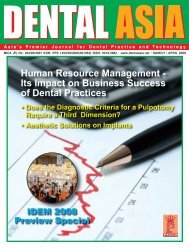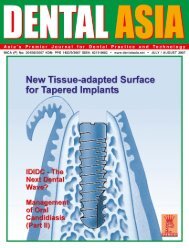Download - Dental Asia
Download - Dental Asia
Download - Dental Asia
You also want an ePaper? Increase the reach of your titles
YUMPU automatically turns print PDFs into web optimized ePapers that Google loves.
CLINICALFEATURE<br />
by Drs Fanny Young & Ricky Wong<br />
The Use of<br />
Motivational Theories<br />
in Dentistry<br />
This article reviewed the theories of<br />
motivation and suggested their applications<br />
in dentistry. These included Maslow’s<br />
hierarchy of needs theory, McGregor’s<br />
Theory X and Theory Y, Motivation-hygiene<br />
theory, Three-needs theory, Goal-setting<br />
theory, Reinforcement theory, Equity theory<br />
and Expectancy theory. An understanding of<br />
each theory can evolve a combined strategy<br />
that can motivate the most difficult patients.<br />
All dentists want to motivate their patients, for example, to improve the<br />
oral hygiene, to proceed to a certain treatment or to wear a certain<br />
appliance. Besides, as an employer or team leader, dentists would like<br />
to motivate their employees, subordinates or team members. In other<br />
words, understanding motivation can be a half way to success. Motivation is the<br />
process by which a person’s efforts are energized, directed, and sustained<br />
towards attaining a goal. It is the result of an interaction between the person and<br />
a situation; it is not a personal trait. In this article we would like to explore the<br />
theories of motivation in an attempt to improve our effectiveness in motivating<br />
others. We start with early theories of motivation, and then the more<br />
contemporary ones.<br />
Early Theories of Motivation<br />
Three early theories of motivation, namely: Maslow’s Hierarchy of Needs;<br />
MacGregor’s Theories X and Y; Herzberg’s Two-Factor Theory provide the bestknown<br />
explanations for motivation, even though their validity has been<br />
questioned.<br />
Maslow’s hierarchy of needs theory<br />
This was developed by psychologist Abraham Maslow 1 . This theory states that<br />
there is a hierarchy of five human needs, from bottom to top: physiological (basic<br />
food, drink, water, shelter, and sexual needs); safety (security and protection<br />
from physical and emotional harm); social (affection, belongingness, acceptance,<br />
and friendship); esteem (internal factors such as self-respect, autonomy, and<br />
achievement, and external factors such as status, recognition, and attention);<br />
24 <strong>Dental</strong> <strong>Asia</strong> • May / June 2008





